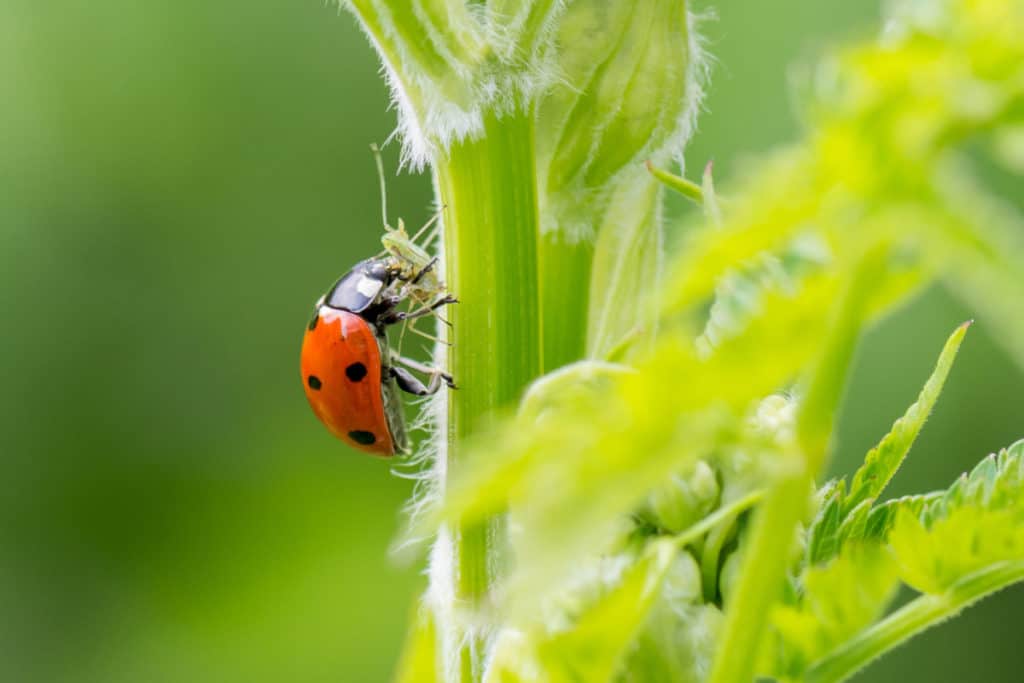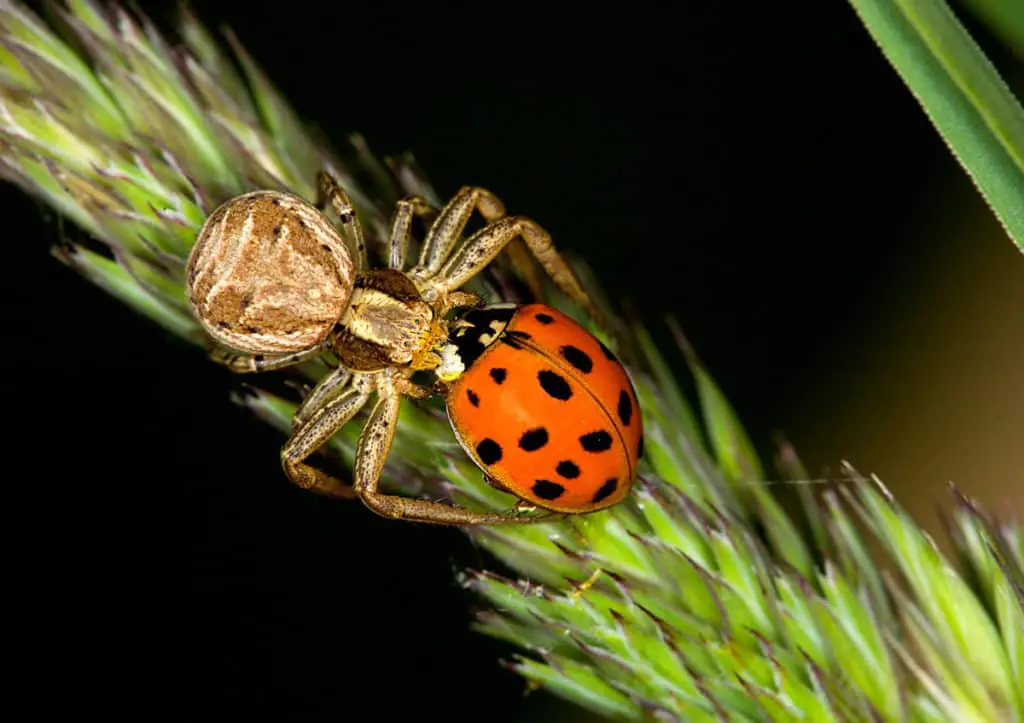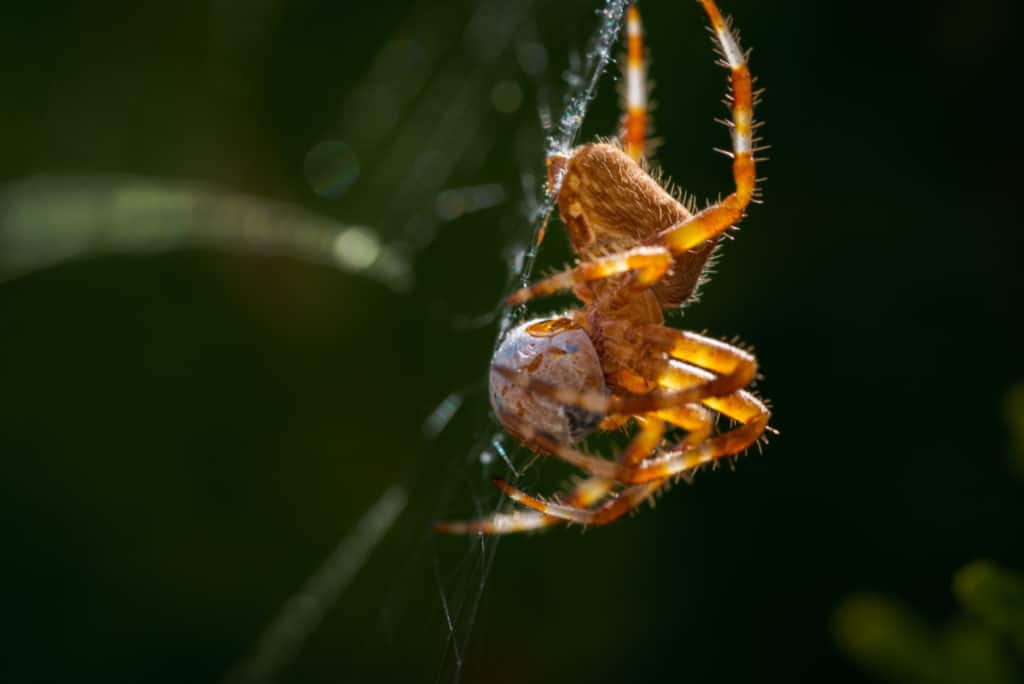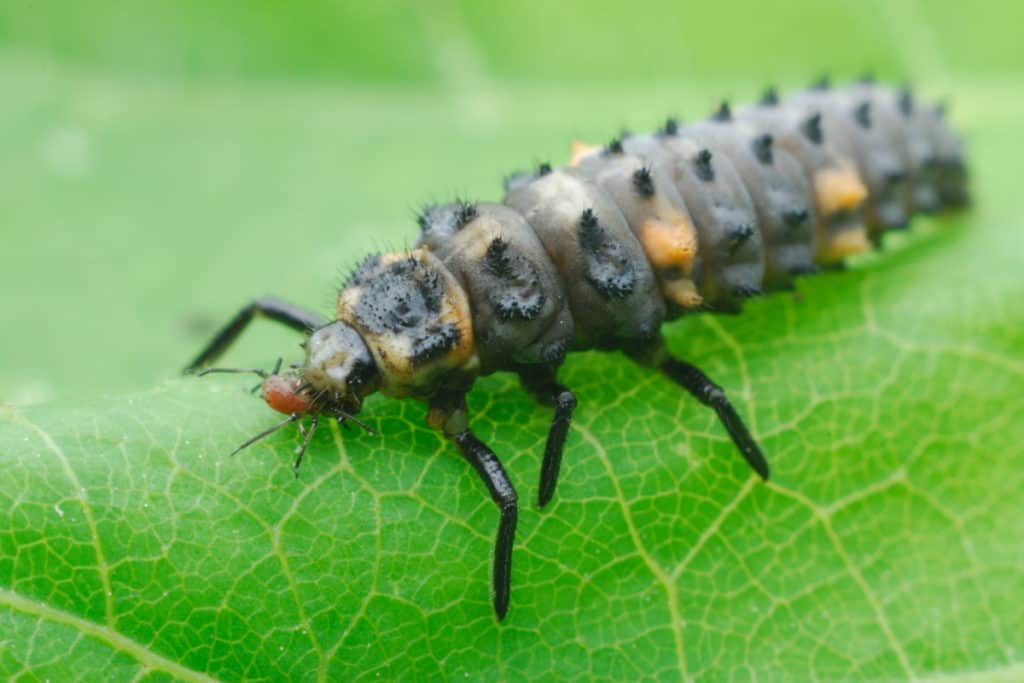Have you ever thought of the round poke-a-dotted ladybug (a.k.a. ladybirds) as adorable or sweet? Of course, your answer is yes. Who doesn’t like them, they are just too becoming.
Well, hold that thought, as it will surprise you to learn that ladybugs are in fact, cold-blooded killers. That the sweet-looking bug is not only a brutal hunter but they prey on a creature with a reputation far worse than themselves………spiders. Who would have thought, right?
Ladybugs whilst striking and very cute in appearance are predatory and carnivorous so yes they do eat spiders, even dead spiders in fact. Unfortunately for ladybugs are more often prey for spiders. One of their favorite foods is spider mites. They are however arachnids… not actually spiders.
This article will answer questions surrounding ladybugs and spiders, such as; What species of spiders do ladybugs eat? Do ladybugs eat spider eggs? Are ladybugs an effective means of spider control? Do spiders eat ladybugs, if so what type? Can ladybugs defend themselves? And are ladybugs beneficial to gardens?
What Species Of Spiders Do Ladybugs Eat?
There are over 5,000 species of ladybugs (Coccinellidae). The type of spiders a ladybug eats will depend on the type of ladybug and what is available. Ladybugs most likely eat spiders that are smaller than them and live in the same region.
There might be some confusion about how often ladybugs eat spiders, because of the spider mite. Most ladybugs eat spider mites as a regular part of their diet. However, they are not spiders.

Spider mites are a type of arachnid making them cousins of spiders and ticks. They are about the size of a punctuation point. They range in color from yellow-green to reddish-orange and typically have 2-4 dark spots on their back.
Short of the spider mites, no specific type of spider is targeted by ladybugs. If a ladybug does eat a spider it would most likely be out of convenience rather than prey that it would pursue.
Do Ladybugs Eat Spider Eggs?
Given most ladybugs’ predilection to eating insect eggs, it is likely that ladybugs would be happy to chow down on nutritious spider eggs if they were able to get a hold of them.
Considering that spiders protect their eggs by wrapping their eggs in silk, hiding them, stringing them up on their webs, guarding them, or carrying them around. Getting to spider eggs can be a tricky and unlikely venture.
It is doubtful that a ladybug would go out of its way to try to eat spider eggs, whilst easier options are available. Such as the unprotected aphid eggs or even its own.
Will Having Ladybugs In Your House Get Rid of Spiders Naturally?
Although ladybugs have an appetite for several critter populations, they will not get rid of the majority of spiders in your house or garden.
The majority of other arachnids do not find ladybugs to be a particular threat. Many of the common garden and house spiders are larger than ladybugs and all of them have effective defenses against potential threats.
Except for the spider mite cousin, spiders and ladybugs can cohabitate houses and/or gardens without significantly impacting either other.
Are Ladybugs Also Prey For Spiders?
Far from being threatened by ladybugs, many spiders consider ladybugs to be viable prey.

Although there are no spider species that make ladybugs a staple in their diets, there are plenty that would not pass up a ladybug meal if it wandered into a web or walked past.
Which Spiders Eat Ladybugs?
There are thousands of accounts of spiders eating ladybugs. Orb-weavers, cellar-spiders, and comb-footed spiders have been observed capturing and eating ladybugs in their webs. Wolf spiders have been seen chomping on a ladybug’s pulpy insides.
The Araneus diadematus, an orb-weaver, seems to be undeterred by ladybugs’ natural defenses. In captivity, this spider happily ate several ladybugs with no adverse side effects.

That said, the Araneus diadematus does not prefer eating ladybugs. An experiment showed that in captivity less than 2% of the spiders ate one ladybug per day.
While some spiders are not put off by ladybugs’ generally bad taste, they also are not keen on them. Choosing to free or eat ladybugs tangled in their webs in equal measure.
Though many of these spiders will eat ladybugs if they are available. Ladybugs remain only as an occasional supplement in these opportunistic spiders’ diets.
For the full rundown on the fascinating diets of various spider species check out this article we have written called, What Do Spiders Eat?
Can Ladybugs Defend Themselves Against Spiders?
Here and there the odd ladybug finds itself trapped in an orb-weaver’s web or caught between a wolf spider’s jaws. However, ladybugs have prevented themselves from becoming a staple source of food through their many defensive characteristics.
For one thing, ladybugs fake it. If a threatening creature approaches a ladybug, the first thing the ladybug may do is to play dead. It will remain still or roll onto its back and curl its legs in until the threat has passed.
Their hard shells prove to be an effective deterrent to many would-be-predators.
Ladybugs are aposematic. Their coloring accurately advertises their toxicity and their bad taste, warning off any would-be predators.
Ladybugs can also bleed at will (reflex blood). If playing dead is not enough, a ladybug can ooze blood (hemolymph) from its leg joints. This blood looks like thick yellow liquid and has a terrible smell and a bad taste effectively rappelling most predators.
In a few types of ladybugs such as the 7-spotted ladybug, this smelly blood also contains alkaloid toxins (coccinelline). Making the ladybug even less appealing.
Scientists found that this coccinelline exists throughout the 7-spotted ladybug’s body, but it collects in the ladybug’s blood. Ensuring that it is readily available to be used in defense.
The process of reflex bleeding expands a lot of energy to maintain. If a ladybug is dehydrated or is in hibernation for winter it will shut down this system to preserve its energy.
Are Ladybugs Beneficial To Your Garden?
If the populations of aphids, mites, mealybugs, and scale insects get out of hand, they threaten the health of gardens and farms. Infestations of these creatures can lead to the death of individual plants and whole crops.
Ladybugs apply their enormous appetites to controlling these unwanted aphid populations, playing an important role in protecting the health of gardens and farms. While not causing any damage themselves.
When a ladybug lays her eggs, she will make sure that they are close to an aphid, insect, or mealybug colony. The ladybug larvae will start feasting on these pests and their eggs as soon as they are born.
A mature ladybug can eat up to 50 aphids per day. While late-stage ladybug larvae will eat over a hundred aphids per day.

Ladybugs can track down spider mites by following the leaf damage caused by mites feeding. If tracking is not enough, ladybugs are also attracted to the chemical smell that spider mites give off.
Being much larger than a spider mite, ladybugs do not spend time on traps or ambushes, but march up to their prey and begin chomping. The average ladybug can eat 100 or more spider mites per day.
That said, there are some exceptions to the helpful ladybug image. These three ladybugs are just as capable of causing damage as the pests they are known to eat.
The leaf-eating ladybug, primarily found in Indonesia and Australia, eats the leaves of various crops.
Found throughout the United States, the Mexican bean beetle is another type of ladybug that eats leaves. Its larvae cause the most damage.
The squash beetle ladybug, a native to the Eastern United States, likes to munch on squash. Though the larvae mostly eat leaves, adults also eat the fruit.
For a comprehensive guide to a ladybug’s diet check out this article we have written. What Do Ladybugs Eat?
Are Ladybugs As Effective As People Claim?
There are thousands of articles online professing claims that ladybugs are a natural answer to all of your pest problems. While most ladybugs are certainly effective at keeping local pest populations under control, they are not a magical solution for all pest problems.
Ladybugs don’t like to stick around. One study shows that about 95% of ladybugs released in a garden flew away within the first 48 hours. The rest left after 5 days. Though this will not be all gardens, it is fair to bet that not many ladybugs will willingly stay where you want them to.
Random (sometimes uncontrollable) variables affect ladybug behavior. One study shows that using ladybugs as a biological control worked in one environment, but exacerbated problems in another. Ladybug behavior is dictated by their own needs and interests, not your interests.
Some ladybugs, such as the harlequin, have become an invasive species. They carry microsporidia and spread them to the local ladybug population. This could have long-term effects on ecology.
The numbers do not add up. Ladybugs thrive where aphids thrive. This study shows that ladybugs will moderate their own population to keep an ideal ratio of predator and prey (aphids). So if you are looking for complete eradication ladybugs are unlikely to help.
Regardless of the problems stated, making your garden appealing to your local (pest-eating) ladybugs is still beneficial. Having ladybugs in residence can help control the pest population and prevent a damaging infestation.
The Wrap Up
There is not much known about spider and ladybug interactions. However given their nature, it is safe to assume that species on both sides would eat the other if given the opportunity.
Otherwise, the main takeaway is that having certain spider and ladybug species cohabitating in your home or garden ensures that the majority of problematic pests will be taken care of without you having to do a thing.
And if you want to reap the full benefits of having ladybugs in your garden it is best to create a habitat that naturally attracts local ladybugs and encourages them to stay. Instead of buying ladybugs and releasing them.
Sources
https://ucanr.edu/blogs/blogcore/postdetail.cfm?postnum=13933
https://science.sciencemag.org/content/341/6152/1342.4.full
http://ipm.uconn.edu/documents/raw2/html/672.php?aid=672
https://extension.umd.edu/hgic/topics/mexican-bean-beetle-vegetables
https://www.emporiumhydroponics.com/ladybirds-versus-spider-mites
https://ucanr.edu/blogs/blogcore/postdetail.cfm?postnum=13933
https://entomology.ca.uky.edu/ef105
https://doi.org/10.1007/BF01240660
http://entnemdept.ufl.edu/creatures/beneficial/lady_beetles.htm
https://extension.umd.edu/hgic/topics/spider-mite-vegetables
